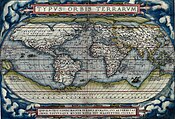| Part of a series on |
| Geography |
|---|
 |
Technical geography is the branch of geography that involves using, studying, and creating tools to obtain, analyze, interpret, understand, and communicate spatial information.[1][2][3][4]
The other branches of geography, most commonly limited to human geography and physical geography, can usually apply the concepts and techniques of technical geography.[2][3][5] However, the methods and theory are distinct, and a technical geographer may be more concerned with the technological and theoretical concepts than the nature of the data.[6][7] Further, a technical geographer may explore the relationship between the spatial technology and the end users to improve upon the technology and better understand the impact of the technology on human behavior.[8] Thus, the spatial data types a technical geographer employs may vary widely, including human and physical geography topics, with the common thread being the techniques and philosophies employed.[9][10] To accomplish this, technical geographers often create their own software or scripts, which can then be applied more broadly by others.[11] They may also explore applying techniques developed for one application to another unrelated topic, such as applying Kriging, originally developed for mining, to disciplines as diverse as real-estate prices.[12][13]
In teaching technical geography, instructors often need to fall back on examples from human and physical geography to explain the theoretical concepts.[14] While technical geography mostly works with quantitative data, the techniques and technology can be applied to qualitative geography, differentiating it from quantitative geography.[1] Within the branch of technical geography are the major and overlapping subbranches of geographic information science, geomatics, and geoinformatics.[6][15]
- ^ a b Haidu, Ionel (2016). "What is Technical Geography – a letter from the editor". Geographia Technica. 11: 1–5. doi:10.21163/GT_2016.111.01.
- ^ a b Sala, Maria (2009). Geography Volume I (1 ed.). Oxford, United Kingdom: EOLSS UNESCO. ISBN 978-1-84826-960-6.
- ^ a b Tambassi, Timothy (2021). The Philosophy of Geo-Ontologies (2 ed.). Springer. ISBN 978-3-030-78144-6.
- ^ Dada, Anup (December 2022). "The Process of Geomorphology Related to Sub Branches of Physical Geography". Black Sea Journal of Scientific Research. 59 (3): 1–2. doi:10.36962/GBSSJAR/59.3.004 (inactive 31 January 2024).
{{cite journal}}: CS1 maint: DOI inactive as of January 2024 (link) - ^ Drake, Dawn M.; Elias, Ashley; Ganong, Carissa; Grantham, Michael L.; Mills, Mark S. (May 2022). "Transforming the Applied Learning Experience Through Interdisciplinary Fieldwork" (PDF). The Geographical Bulletin. 63 (2). ISSN 2163-5900. Retrieved 4 August 2023.
- ^ a b Sala, Maria (2009). GEOGRAPHY – Vol. I: Geography (PDF). EOLSS UNESCO. Retrieved 30 December 2022.
- ^ Cave, Edward (1749). Geography reformed: a new system of general geography, according to an accurate analysis of the science in four parts. The whole illustrated with notes (2 ed.). London: Edward Cave.
- ^ Lin, Yuancheng; Wang, Min; Lei, Junchao; He, Huiyan (3 August 2023). "Perception and Interaction of Urban Medical Space from the Perspective of Technical Geography: A Case Study of Guangzhou, China". Journal of Urban Planning and Development. 149 (4). doi:10.1061/JUPDDM.UPENG-4432. S2CID 260653708.
- ^ Arabi, Mouhaman; Ngwa, Moise (March 2019). "Modeling the Relationship Between Weather Parameters and Cholera in the City of Maroua, Far North Region, Cameroon". Geographia Technica. 14(1):1–13 (1): 1–13. doi:10.21163/GT_2019.141.01.
- ^ Boehm, Richard G.; Peters, Samantha (2008). Careers/Jobs in Geography:Business Cards of Department Graduates (PDF) (sixth ed.). Texas State University San Marcos. Retrieved 8 November 2023.
- ^ Kretzschmar Jr., William A. (24 October 2013). Schlüter, Julia; Krug, Manfred (eds.). Research Methods in Language Variation and Change: Computer mapping of language data. Cambridge University Press. p. 53. ISBN 9781107469846.
- ^ Cite error: The named reference
Monmonier1was invoked but never defined (see the help page). - ^ Chilès, Jean-Paul; Desassis, Nicolas (2018). "29 Fifty Years of Kriging". In Sagar, B. S. Daya; Agterberg, Frits; Cheng, Qiuming (eds.). Handbook of Mathematical Geosciences. SpringerOpen. p. 589. ISBN 978-3-319-78998-9.
- ^ Holler, Joseph (2019). "Human Geography with Open Gis as a Transformative Introductory Higher Education Course". The International Archives of the Photogrammetry, Remote Sensing and Spatial Information Sciences. 4214: 99–106. Bibcode:2019ISPAr4214...99H. doi:10.5194/isprs-archives-XLII-4-W14-99-2019.
- ^ Cite error: The named reference
Bello2023was invoked but never defined (see the help page).
© MMXXIII Rich X Search. We shall prevail. All rights reserved. Rich X Search
